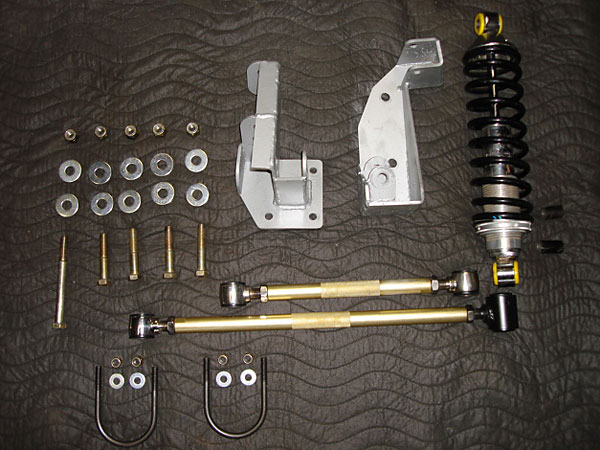
New MGB 4-Link Rear Suspension from Classic Conversions Engineering
The British V8 Newsletter, Volume XV Issue 3, December 2007by: Curtis Jacobson
Background
What are the weakest links of the original MGB? Many critics would answer the rear suspension.
It's not a question of durability - the main issue is ride quality. Looking over old MGB magazine
reviews (including most of the MGB GT V8 articles we've reprinted in this issue of the Newsletter)
you'll notice that complaints about ride-quality were one of biggest and most persistent gripes
about MGBs in their day. Especially at low speeds, road shock comes right up through the leaf
springs and into the driver's spine. The problem is worse when an engine transplant is performed.
Stock leaf springs are ill-equipped to deal with increased engine torque. The usual result is
noticeable "axle tramp" on acceleration. As the front sections of the leaf springs wind up and
unwind, they're also subject to premature sagging and/or leaf breakage.
MG was aware of the ride issue long before the first MGB was even built. According to an
interview of MGB designer Don Hayter (which I found in Ken Smith's excellent little book
"Aspects of Abingdon" as published by MG World, copyright 2006), the very first MGB prototype
was fitted with a trailing arm and coil spring rear suspension that included a Panhard rod
for side-to-side axle location. A similar suspension had been installed on MGA developmental
vehicles. The factory engineers preferred coil spring suspension over leaf springs to achieve
a smoother ride. Ultimately though, MG engineers were unable to overcome a slight steering
effect caused by fitting a too-short Panhard rod. The "ox cart" leaf spring suspension they
ultimately carried over from the MGA was "cheap and cheerful", but many of us have been
tempted to upgrade or replace it.
- It's difficult to finely adjust ride height on a leaf spring suspension.
- It's a pain to readjust ride height as the leaf springs sag over time.
- Easy ride height adjustability makes rubber-to-chrome bumper conversions easier.
- Maybe you'd like to tune "corner weight" loading to balance the car side-to-side?
- Today's stickier tires let us corner harder, which calls for better side-to-side axle location.
- Our taller, wider tires may rub against our fenders unless we improve side-to-side axle location
- Leaf springs are heavy. (Insert your favorite Colin Chapman quote here... Besides, the heavy weight of the
leaf springs and axle forced MG to use uncomfortable shock dampening characteristics in the first place.) - If we have axle tramp, we're losing acceleration potential and we're risking dangerous leaf spring failure.
- If we fit low profile tires, we don't get as much shock absorption in the tire sidewall.
- With hi-torque engines and overdrive, we need to change axle ratio and we want a limited slip differential.
The most economical way to get these is usually a narrowed American-made axle. When we fit that
narrowed Ford, GM, or Dana axle we'll probably need to adjust axle pinion angle too.
The all new Classic Conversions Engineering "4-link" rear suspension addresses all these issues
quite elegantly, and it even addresses them without a Panhard rod.
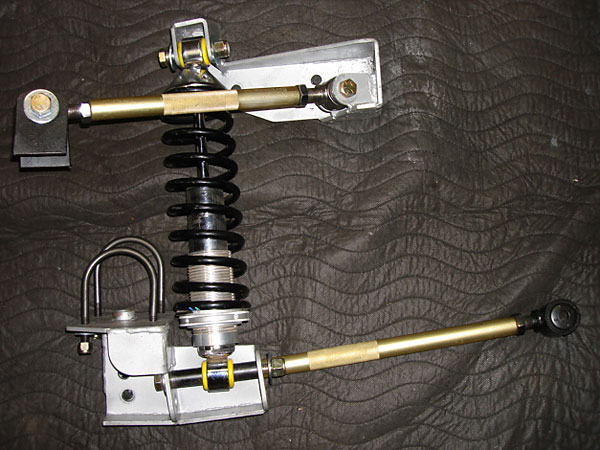
Features of the Classic Conversions 4-link Rear Suspension
The Classic Conversions 4-link rear suspension features coilover shock absorbers in lieu of
heavy leaf springs and the MGB's original Armstrong knee-action shock absorbers. As soon as
your UPS guy delivers the box, you'll know there's a big weight difference! The suspension's
creator, Bill Guzman, advises us that the Classic Conversions 4-link suspension weighs about
47 pounds less than a stock MGB rear suspension.
As soon as you see the coilover shocks and their mounting brackets, you'll understand another
of his suspension's biggest selling points. It facilitates exceptionally easy adjustment and
fine-tuning of ride height. Ride height can be adjusted by placing the shock in either one of
two mounting holes on the axle bracket. The lower position nominally places the car 1" below
stock ride height. Subsequently, ride height can be precision adjusted by rotating the threaded
lower spring perch on the coilover shock absorber's body. According to Bill, with the spring
perch threaded to its lowest position, your car's static ride height should be two inches below
a "chrome-bumper" MGB's factory-original ride height.
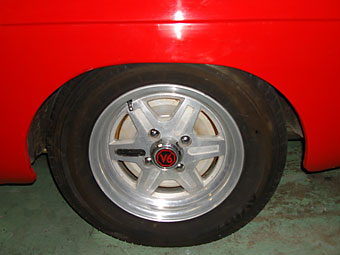
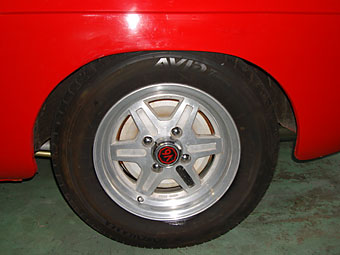
These two photos show the suspension's lowest and highest static height settings.
Bill also advises that Classic Conversions will introduce a new, matching MGB front suspension next spring that will be similarly adjustable at the front of the car. Although most of us are content to just level (and lower) the ride height and leave it at that, easy adjustability at all four corners will allow some of us to equalize "corner weights" to get the very most traction out of our tires (for competitive autocrossing, etc.)
Enjoying this article? Our magazine is funded through the generous support of readers like you!
To contribute to our operating budget, please click here and follow the instructions.
(Suggested contribution is twenty bucks per year. Feel free to give more!)
The Classic Conversions Engineering 4-link rear suspension also facilitates four wheel
alignment. In other words, you or your alignment shop can easily adjust the suspension to make
sure the rear axle is tracking straight. You can also easily adjust the rear axle's pinion
angle, or dial in a little bit of anti-squat characteristic to the rear suspension.
Want easily adjustable shock absorber valving too? The coilover shock absorbers that are
standard equipment with the kit are made by Carrera, but Alden aluminum adjustable
coilovers are available at an additional cost.
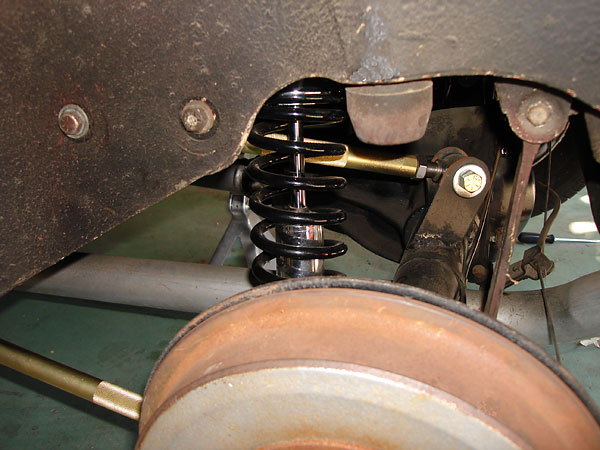
The Classic Conversions 4-link is designed to be simple to install. Only a minimal amount of welding
is required, and the welds in question (shown here) are of heavy gauge brackets to the top of the axle
tubes. If you're not comfortable welding, this job wouldn't be very expensive to farm-out locally.
Easy Installation - Suits a Broad Range of Applications
The Classic Conversions 4-link rear suspension is designed to be installable in one
afternoon. (Whether this is really possible will depend on what's in the way. You
may have to alter your exhaust system, etc.) The design utilizes the MGB's front leaf
spring mounting holes, and the bolt holes for the old knee-action shocks. Just to set
the record straight for purists: this installation is completely "reversible".
This design should also work equally nicely with all the popular stock and aftermarket
axles: either MGB's "banjo" or Salisbury axles, and with either lugged or splined hubs,
plus also narrowed Ford, GM, or Dana axles.
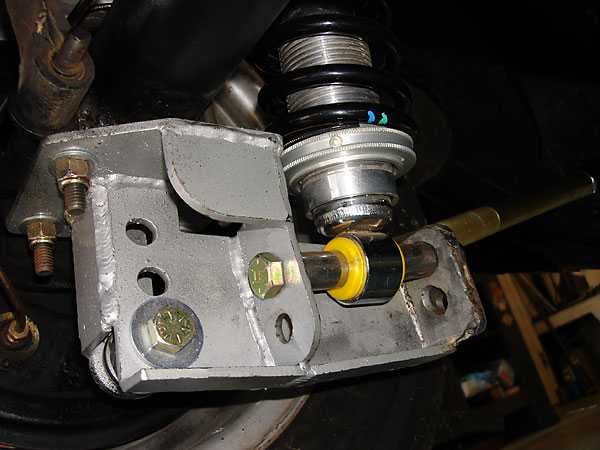
Designed for serviceability...
Although the system is durable and intended to last for years without modification,
it's also designed to be easily serviceable. Spring changes, for example, are just a
matter of unbolting the bottom bolt of the shock, unscrewing the spring-perch nut, and
replacing the spring.
The coil spring for the GT has a nominal rating of 160 lbs per inch, and the coil
spring for the roadster has a nominal rating of 140 lbs per inch. Both GT and
roadster kits utilize the same shock absorber valving.
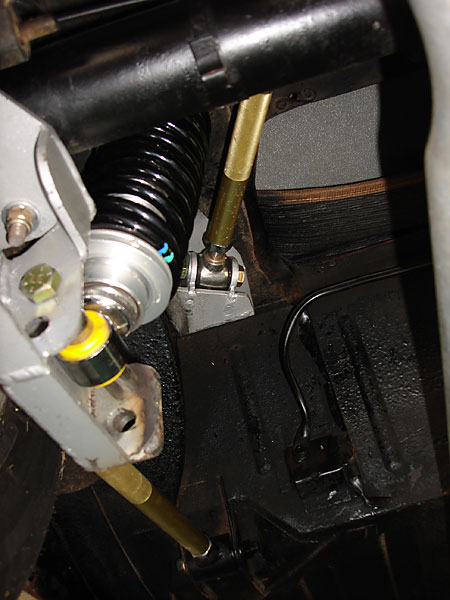
Top links are angled inward...
All four of the suspension links are custom made out of gold anodized 6061-T6 aluminum. The links feature 5/8" threaded stainless-steel rod-ends with urethane bushings, and they have right-hand threads at one end and left-hand threads at the other for easy adjustability. So long as the rod-ends don't bind up, the rods can only be loaded along their axis, in tension or compression. The rods are sufficiently strong to eliminate axle tramp (assuming that the rear axle itself is rigid).
How Does It Function?
Notice in the photos that the top pair of links are angled-in toward the center of the axle.
This design was chosen to make a Panhard rod unnecessary. Working together, the two links
should positively locate the axle from side-to-side. Of course there will be some side-to-side
motion due to compliance in the rubber bushes, but compared to the original MGB suspension
the car should feel more secure on turns, tire scuffing on the wheel wells or fender-lips
should be avoided, and you may be able to fit wider tires.
Let's digress and review for a moment what a Panhard rod is and how it functions. A
Panhard rod is a single link mounted parallel to the rear axle with one end mounted to
the axle and the other end mounted to the frame or body of the car, usually for the sole
purpose of keeping the axle centered. Panhard rods can be made to work great, and they're
both simple and cost-effective - but they can also cause problems! Think for a moment of
the axle end of the Panhard rod as being positively fixed in space, with the rest of
the rod free to pivot around it. When the car goes over a bump, the body end of the Panhard
rod must move up and down relative to the axle. Since the rod is rigid and has a fixed length,
the body also gets shoved a little bit side-to-side as the rod-end swings through an arc.
A longer Panhard rod induces less side-to-side motion for a given amount of up-and-down
motion. (Take a ruler and compass to some paper if you need to prove this to yourself.)
Thus, Panhard rods should always be as long as feasible!
By not using a Panhard rod, the Classic Conversions 4-link has avoided the induced
steering effect on bumps that MG engineers reportedly had with their coil-sprung rear
suspension prototypes.
Another inherent feature of the new Classic Conversions suspension is "anti-squat".
Bill tells us that the suspension links have been deliberately angled to counteract
compressive force at the rear springs as the weight of car shifts rearward. The result
will be added traction and improved acceleration when exiting corners.
Speaking of cornering, how does the suspension react to body roll in turns? Does the
geometry of the suspension cause the rear axle to cock slightly to one side, thus causing
"roll steer"? When just one rear wheel hits a bump, will the driver need to make a steering
correction due to "bump steer"? If there is indeed a roll steer effect, how strong
is it? Does the effect tend toward "under steer" or "over steer"?
Bill advises that the Classic Conversions 4-link has a slight roll steer characteristic
which is in the direction of over steer. In other words, as the body pitches in a turn
it will tend to cause the car to steer a tighter line.
Later model MGB axles were equipped with a rear anti-sway bar. It was mounted just above
and parallel-to the axle and its two arms extended forward to mounts on the body.
(Click here to see
what these anti-sway bars looked like.) If your car is equipped with this style
anti-sway bar, it will need to be removed before the top links of the suspension can
even be installed. The new 4-link rear suspension was designed to be used without a
rear anti-sway bar.
Bill has rigged up a static roll-test and been unable to induce binding in any suspension
pivot through the full travel of the suspension. All of the bolted joints in the
suspension are in double-shear. The suspension is provided with all the SAE Grade-8
hardware required for installation.
The Classic Conversions four-link rear suspension kit is priced at $1,228, plus shipping.
Through March 31, Classic Conversions is offering a special introductory discount price
of just $1103, plus shipping. With optional Alden shocks instead of the standard Carrera,
add $180.
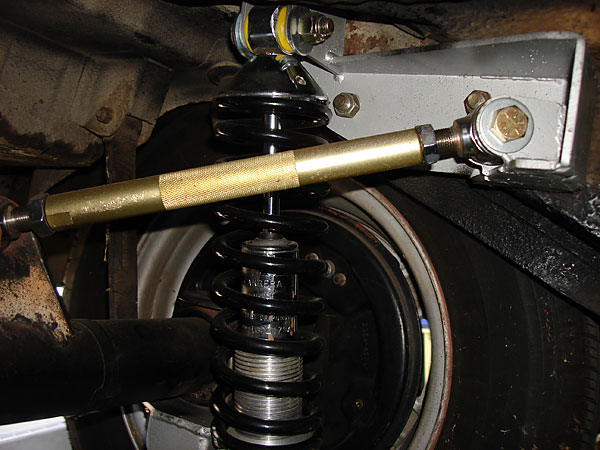
The upper chassis mount uses the old shock absorber mounting holes.
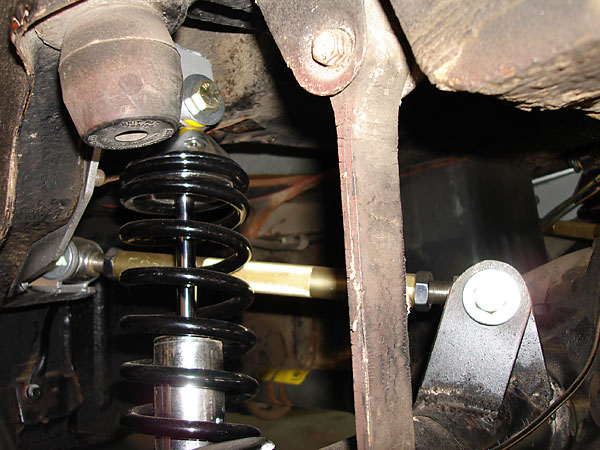
Stock bump stops and rebound straps can be left unchanged.
(For added safety, when you weld the mounting tabs onto your axle you may want to weld a simple
reinforcement strap or two between them to reduce the likelihood of fatigue cracking in the welds.)
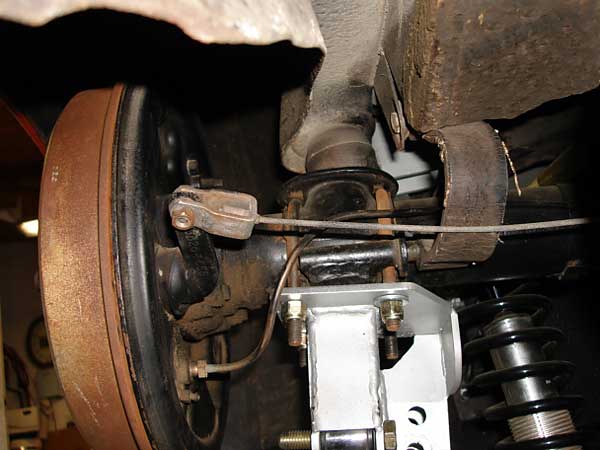
The Classic Conversions 4-link provides a full range of suspension travel without binding.
(The lower end of the shock absorber has been disconnected for this demonstration photo.)
Photos by Bill Guzman. All rights reserved.


